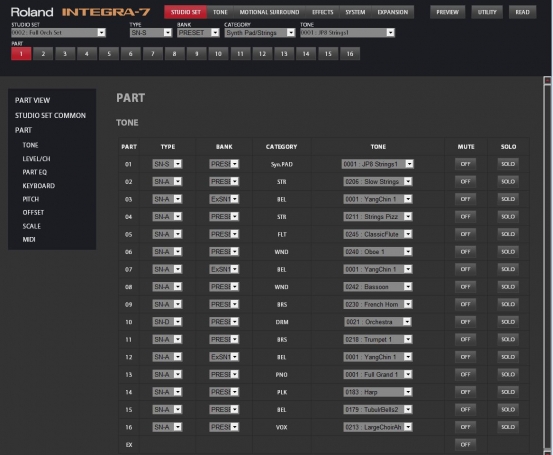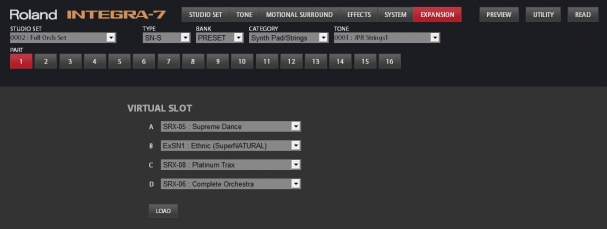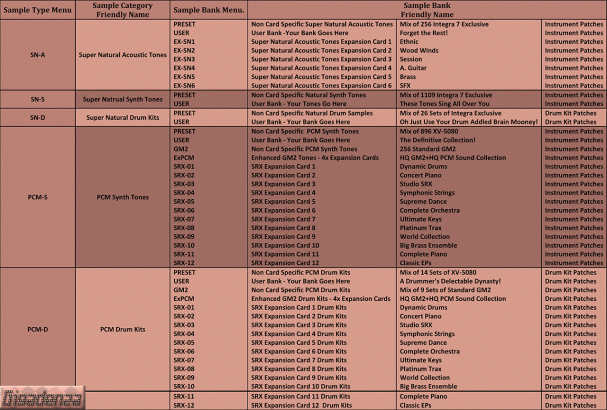Roland Integra 7
Ultimate XV Tribute? Luxurious Rompler with Lamentable Limitiations? Flawed Masterpiece? You Decide!
The latest, heaviest and arguably, most abundantly adorned, sonically pure and stunningly versatile case of oscillating liqueurs in my collection. Again I must lament over the absence of an analogue artisan amidst such billowing swarms of samples, however stirring they may be but if Moog’s magic has fostered the finest creations a binary free paradise can bestow, Roland’s intoxicating Integra surely came close to a definitive demonstration of the delights delivered by a digital utopia.
A rack mountable relic with detachable ears, this handsome machine could be easily mistaken for an amp or media streamer and looked equally at home when perched on a desk, reclining on fashionable coffee tables or indeed, any surface that could accommodate its imposing 24x43cm frame. However, upon closer inspection, one noted the diligent diagram elegantly embossed atop the roof, aptly illustrating but a fraction of its fabulous potential.
Whatever the century or decade, no matter the age or era, when it comes to to adjudicating audio excellence, a ubiquitous community of cantankerous experts will ensure every contemporary device endures a crippling cacophony of crotchety criticism. If it didn’t warrant their investment, it isn’t worth anyone’s, and everyone must know.
Probe a little deeper, read between those pious posts and almost without exception, one discovers it is they who have pawned pearls from Nana’s ear rings to acquire one of their subject’s ancestral counterparts. The rhetoric of any such crowing cynic casting a caustic eye over the Integra would be rigorously reduced to rudimentary rancour. For it it is difficult to rationally dismiss a premium product whose design was not only influenced by a roundly revered heritage, but directly incorporated the defining elements of several senior siblings.
SRX boards, remember them? The perfect gift for your faithful furnisher of frequencies. Bite sized PCBs bursting with 64mb of luscious loops dedicated to making your brass broader, your woodwind warmer, your strings sweeter and pianos prettier….for once let’s cut this alliterative adulation short.
Since their introduction in 2000, an impressive range of sixteen, including a quadrilogy of “special editions” had inhabited the headphones of incisive engineers. Of these, a tremulous total of twelve had trotted into regular retail, ok I mean it this time.
The Integra 7 stood in a direct line of “JV” and “XV” descent, two families of elders whose penchant for packs of potent PCM patches became a long standing tradition, I’m warning you! Those from clan XV eagerly savoured SRX cards whilst esteemed JV guild members relied on those from the “SR” series, which numbered over twenty but typically provided a fourth to an eighth of the storage space.
Hey…utter the purists in unsettled unison, greater memory does not always coincide with superior quality, rarely in fact, listen to the two orchestral boards, authentic enough for the most critical professional, convincing enough to complement a crop of film scores. Where would you find finer loops, or a more sincere form of acoustic acclaim?
Indeed, and who with credible listening skills would challenge such waveforms of wisdom? Apparently, not even Roland themselves. For in a bold bid to avoid fixing what wasn’t broken, they conscientiously populated several SRX modules with complete sample sets lifted from this copious archive of SR superlatives. Having trousered a tidy sum from offloading a loaded JV-1010, upgraders to say, a Fantom XR, could reap the benefits of their new purchase, bask amidst inspired masterpieces and compose another with the electric ensemble that had ignited their fame and fortune.
If you haven’t yet slumped into a coma, you’ll be wondering why these succulent slices of sonorities have so stimulated my salivary glands – oh can it get any worse! Well, just before we inspect the Integra’s most alluring treasures, its worth emphasizing why a product whose premier retail price sat a shade south of £1200 could be argued to constitute a breath snatching bargain.
I’ve already mentioned one redoubtable forefather, the JV-1080, 640 tones out of the box, crammed onto an 8mb ROM and customisable down to the nuances of each contributing voice (remember, voices make up tones, atoms make up molecules!). 64 voice polyphony, 16 parts, one timbre for each and six 1/4 inch outputs on the rear. Price at launch? £1085 (according to Soundonsound). Space for four “SR” expansion cards but none supplied as standard.
How about the JV-2080. The magnificent next of kin. The Jehova in the “JV” bloodline. ROM size, the same. Audio outputs, as before. Polyphony, identical. Timbre count, no change. Tones tallied 768, 40 flavours of EFX essence were added and scope for expansion rose to eight “SR” slots…all of them empty. Present a cheque for £1399 in the spring of 1997, and its yours.
Let’s consider the XVs. First up, the XV-3080. The admirable apprentice in a partnership of two. Default tonality now stood at 1152 vibrant patches, vigorously vibrating atop 32MB of ROM and sheltering amongst its ranks all Daddy JV-2080’s originals.
Poly prowess 128, part potency 16 and timbres to match. Hex-way quarter inch hardware outputs and comfortable accommodation for four SRX residents…but sadly, once again, none present on the grand day of opening. Draw a wad of 130 crisp tenners from the wall and you’ll receive a pound to fund your journey back home.
Stalwart efforts to be inventive when imparting lists of specifications should illuminate the author’s grey matter and give rise to a pleasurable reading experience, that is, until a scarcity of smilies leads to puerile pretension.
As I fear that delicate balance may be about to tip, I shall convey following comparison in the most honest fashion my heart head and soul shall allow…. with a fabulous fact laden TABLE!!!!!!!!!!!!
Why? Because it pits my Integra’s resounding resume against that of the one beast I’d concede to be worthy of its waveforms.
The XV-5080. Having never seen, heard or touched one in anger, my love for this enviably appointed MIDI Megalodon was and remains absolute. I was desperate to stash one mint, to tenderly lift it from its box, smell the fresh polystyrene and the mint pages of a manual I’d never read.
You know me to foster a Fantom XR, a supposedly superior descendant. Stock samples with a higher bitrate, a native wave ROM twice as capacious, built-in sampling, time stretching and detailed editing, room for four times the RAM. And yet, having combed countless threads thriving with the knowledge of true sonic scholars, were I offered a spotless 5080 in trade, I’d snatch it in a hemi-demi-semi quaver.
A match-up pulsating with potential, and why I refrained from disclosing the Inegra’s key attractions. Though frequently cited as the Fantom XRs intended heir, to me it seems that with hindsight, Roland judged the latter’s physical and technical merits sufficiently divergent from those featured in its XV brotherhood to induce a second, more profitable chance of honouring their momentous retirement and official relegation to a status of fusty, dusty legacy.
Were they anxious to try again? Did subsequent market research suggest a sizeable contingent of customers had peevishly passed up the Fantom, but might well make the jump were the traits of their cherished 5080 more thoroughly reproduced?
We don’t know. Nevertheless, save for a lack of on-board sampling, the Integra all but begs to be hailed as a homage to fleet XVs mother ship, endowed with every one of her native tones and a near identical array of audio outputs.
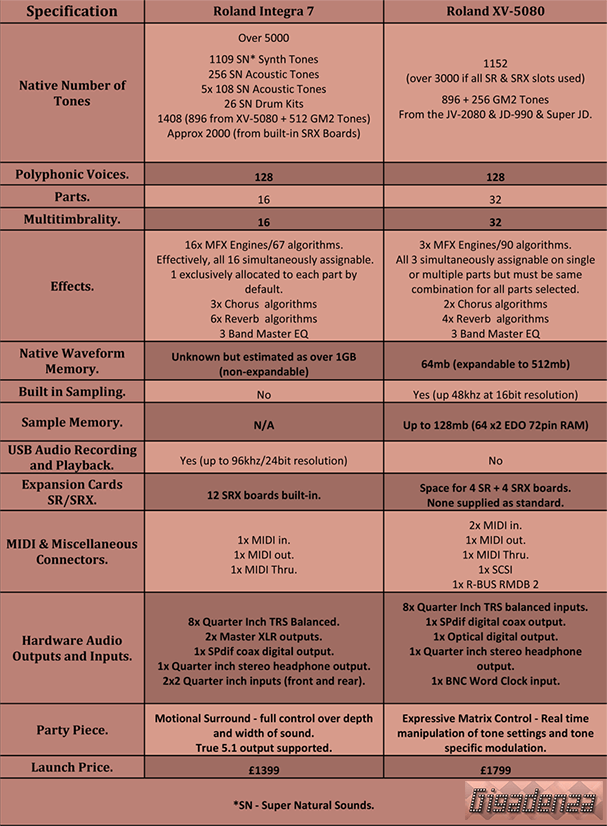
So what of the discrepancies? The XV, twice the parts, profoundly desirable. The Integra, a pair of XLR outputs – XLRs define professionalism and ooze appeal, even if you never use them! The XV, a qualified sampler with optical digital input and word clock inputs. The Integra, a high quality audio recording and playback interface with two pairs of stereo inputs.
The XV, three magnums of mulled MFX magic with 90 dynamic flavours, mixable on any or all of its parts in the portions you decree. The Integra, sixteen bottles of the same FX vintage harbouring 67 bedazzling bouquets, no infusions but every part individually served to order with a rare and exotic blend of incremental strength. Sorry, just a slight resurgence of smilies, won’t happen again.
The XV, two MIDI inputs to the Integra’s one, plus SCSI and R-BUS connectors, obsolete to the majority but always worthy of reference. So far, it seems the XV has edged ahead. A MIDI maestro with more than a grand to fritter would likely favour timbrel tissue over inherent audio capture and entrust a dedicated, “gold standard” solution to manage an intensive A/D D/A workflow.
But while no singular asset, however outstanding, should secure a synthesiser unanimous adulation, those fundamental and common to all take a logical precedence over transient gimmicks, and one of indisputable attraction and significance, is the repertoire, richness and resonance of tones.
We’ve already gathered the Integra comes laced with “Ye Olde 5080’s” luxurious library of loops. Out of respect, do we declare stalemate? Not quite. What of expandability? Glance one more at that lavishly lucid table.
The XV, space for eight sonorous side orders. Four slices of soft, succulent SR sponge of the traditional Victorian variety and four further, thicker slabs of creamy SRX crumble, with a fiendishly fruity and festive charm. However, yet again both cupboards were bare. Where those crochety, quavery treats should loiter, there was merely space.
How I weep as I wish for more wondrous wavs upon which my ears can gorge. Wait! I chose the Integra, not the 5080. Go on, one final time, the table of truth. Look! Not just the XVs assonance and dissonance and full oratorical virtuosity, but almost four thousand more samples besides. Room for eight expansion boards at over £150 a pop? I hardly think so. How about all twelve cards in the classic series, supplied as standard, to complement your scrumptious synergy of “Super Natrual” Synth and Acoustic” spices. Take it, the entire tray-bake of tonal delight.
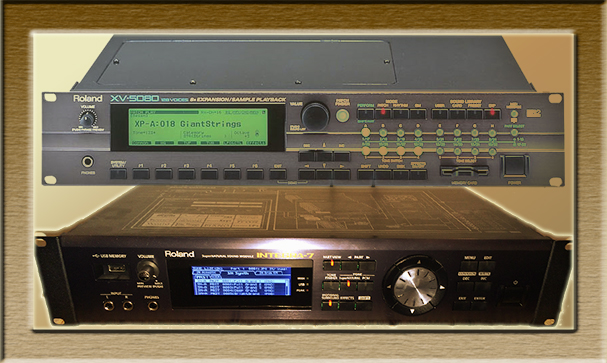
Like every other Synth under scrutiny, each of the Integra’s parts could encompass one tone and ascribe it parameters pertaining to colour, texture, shape and dimension. Though only 16 parts strong, the range and depth of customisable elements this ravishing rompler affords each, is beyond rational reproach. For instance, Sc-8850 sports a 3 band master EQ, which after dialling in the desired values, can either be present or absent on the parts you pick. The Mu-2000 goes further. A 5 band master EQ common to all channels and constantly active, plus a 2 band EQ assignable to specific parts in uniquely adjustable amounts.
The Integra gives the boat one final shove with a triple band Master EQ, implementable on separate and collective parts. A second, dedicated three band EQ for each part with independent granularity and a sextet of 3 band EQs exclusive to the drum channel with an accompanying compressor. Enter the frequencies, attack and release times, gain and ratios you wish for all six, then send them either to channel itself or to any combination of the eight quarter inch outputs as a mono or stereo signal.
Not enough control? Here’s the coda. Communal reverb and chorus algorithms could attend to any pair of jacks in stereo and as individual entities whilst all 16 parts with their allotted patches and delicately crafted collages of chorus, reverb, pan, volume, velocity, pitch, key and vibrato could permeate an unconditional choice of outputs.
Please don’t flatter to deceive. When was the last time you mentioned the 5080? Oh yes, conveniently, just prior to fawning over the Integra’s excellence of EQ and vastly versatile routing virtues. You’ve danced away from the core issues and introduced two older synths, conveniently inferior in this respect but better equipped in others – when it comes to jack generosity and EQ agility, the 5080 barely trails, indeed, it might even steal the upper stave.
You’ve glossed over the “Party Pieces”, I’ll bet your imperturbable Integra has nothing like Expressive Matrix Control….HALT, and I’ll wager your extraordinary XV exhibits no equivalent to Motional Surround! I’ve availed neither nor covet to do so, thus, how about we canter to our table’s closing entry, perhaps more significant than any and unearth my most persuasive argument.
As much as you can exalt the XVs, fawn over the Fantom or juice up a JD. If we’re talking pound for pound, launch dates aside, all else being equal, the XV’s exclusion of any top up cards proves conclusive. The Integra, bearing a dozen deluxe bundles of delicious beats and sumptuous scales, is a veritable confectionery of voices that arrived on the high street for £400 less.
A Sneerer and Sniper May Say.
HA! So you have twelve sparkling SRX smorgasbords, six seductive Super Natural symphonies and a gleaming gamut of GM2 grandeur…out of which only a quartet can be assembled. No, wait, it’s worse, choose the General MIDI banks and you populate all four virtual slots.
Sure, neither the Fantom or XV dealt a card of courtesy, but when all slots were spoken for, six in the Fantom, eight in the XV, the whole heaving humming, heavenly, harvest of transcendent tonology awaited your eager ears.
Why, where’s the logic? DRAM is dirt cheap, simply shove in a couple of extra DIMMS and have all twelve freely accessible the very instant you press for action? Instead, we’re stuck with an exasperating five second pause every time we want to switch boards.
We have different projects in Cakewalk and Cubase that use a ton of combinations, now we have to keep a militant record of which boards relate to each before lending the closing bars of that masterful melody our undivided attention. What a missed opportunity. The minutes, the hours, the days saved for leisure and pleasure would’ve sealed a deluge of deals.
One Final Little Tool
Well, to ease the pain a touch, there exists a software editor, freely downloadable from Roland’s website and installed in a contemporary VST compatible application such as Cakewalk Sonar or Steinberg Cubase whereupon it is detected as a “VST 3” soft synth.
Having never curated Cubase I’ve no knowledge to impart but in Sonar, the user “inserts” it as one would a standard plugin, prompting the creation of a track and the tool’s appearance in the synth rack. A double click reveals its interface, which affords quick and satisfying interaction with the Integra’s catalogue of functions. From here, clicking “Utility” (top right) then “Device” (left, third up from bottom) presents us with the menu to determine input and output devices.
The selection here is vital and conducive to avoiding niggles I resolved via my usual “guess and press” approach. It must be “Integra-7 CTRL” under BOTH fields and not “Integra-7” or any other option you might have listed.
Moving on, a tap on “READ” will deliver all the data from the Integra to the application’s menus where every one of its plentiful settings could be modified with with the same forensic precision as on the unit but via an infinity more familiar and practical protocol of point, click and drag!
Instrument definition for every part along with its full complement of customisable characteristics. Individual screens for each category of effects, including Motional Surround, MFX, Chorus, Reverb, Master and Comp+EQ and all their tunable trinkets and extra over for Part EQ gains, pitch shift with coarse and fine tuning. Part offset, scale adjustment, key, pan and level governance. Chorus and reverb send levels and output designation, all laid out in a spreadsheet style and accessible “at a glance”.
Last but not least, a special menu for loading and ejecting all nineteen SRX and SN expansion modules to and from the Integra’s modest quadrilogy of virtual slots.
The lions share of alterations commanded by the user are reflected immediately, even though the LCD isn’t synchronised with the GUI. Dragging a slider or clicking an applet will cause the USB activity LED to flicker, indicating changes are being committed.
In closing, its worth alluding to the Integra’s reliance on a propriety “Studio Set” template system.
Studio sets are best described as giant portfolios of pre-sets administrable to the machine by way of a single click. Housed within each is data applicable to every feature cited above and all those left to chance-and there are hundreds of them!
Out of the box, there are sixteen pre-programmed studio sets and accommodation for 47 user defined templates. Pre-assembled sets also contain space for user data. For example, in each set, all samples are categorised on a hierarchical basis. At the top end, after the studio set itself has been initiated, one specifies an option from the “TYPE” menu, determining the sample sub-group.
Next in the chain is the “BANK” menu, the options Displayed here are influenced both by your selection above under “TYPE” and the expansion cards you have loaded in the four virtual bays. The table below illustrates the correlation between “Banks” and “Types” and how their abbreviated names when listed under each menu, correspond to those written in proper English.
Two choices are always present “USER” and “PRESET”. “PRESET” refers to the uncategorised drum and instrument patches native to the Integra as well as those from the XV-5080 and “USER” to a Carte Blanche awaiting your input. Clicking on “UTILITY” provides us a patch designation screen where every instrument and drum kit can be nominated from the remaining two menus in the hierarchy, “CATEGORY” AND “TONE and take up its place in the bank by clicking the “write” button next to the desired patch number, thus generating a brand new “USER” bank, in my case….very slowly.
Should you have the need, or indeed the patience to stitch an entire Studio Set from scratch, it can be stored and deployed to the Integra in two shakes of an index finger.
In use general use, navigation is a trifle clunky, load times could be snappier and the menus themselves are decidedly drab when compared to the polished graphical mixers offered by the Fantom XR’s and SD-90’s edifying editors. Nevertheless, the experience of tweaking, tuning, teasing and trimming every meaningful attribute this samplicious sage bestows with sensitive sliders on a 4k display beats burdensome button bashing boredom, however luminous the LCD.
An Epilogue THRU MIDI
Please don’t read this if you’ve already sampled the Fantom’s menacing “MIDI THRU Prelude”, the similarity is quite terrifying.
If the option “USB MIDI Thru” is set to enabled, when the unit receives a MIDI signal either directly through its MIDI input or via that of another USB device connected to the same computer, such as an additional synthesiser or MIDI I/O adapter, the Integra’s MIDI 1 output will behave exactly like a conventional MIDI THRU port and re-broadcast these signals to any device that is connected to it.
However, this will only be possible when a program that fully utilizes the Integra’s USB driver and that of the other device – if applicable – is running. Prime examples would be sequencing software such as Sonar, Cubase and Logic.
The function will also enable the MIDI OUTPUT to relay data that originates from internal transmissions, such as those generated when a MIDI recording is played back in one of the above applications on tracks to which the Integra’s instruments have been allocated, or that occur when a MIDI file is opened up in utilities like QuickTime or Media player and the Integra has been specified as the OS’s default MIDI device.
When this feature is enabled, the unit will be able to play back tones and simultaneously forward the data to its midi output but will remain silent in standalone mode when receiving signals from an external controller.
By contrast, the MIDI THRU port will never forward internal playback signals, but will always duplicate those received by the Integra’s MIDI input to a connected device, regardless of whether or not USB MIDI thru is active.







